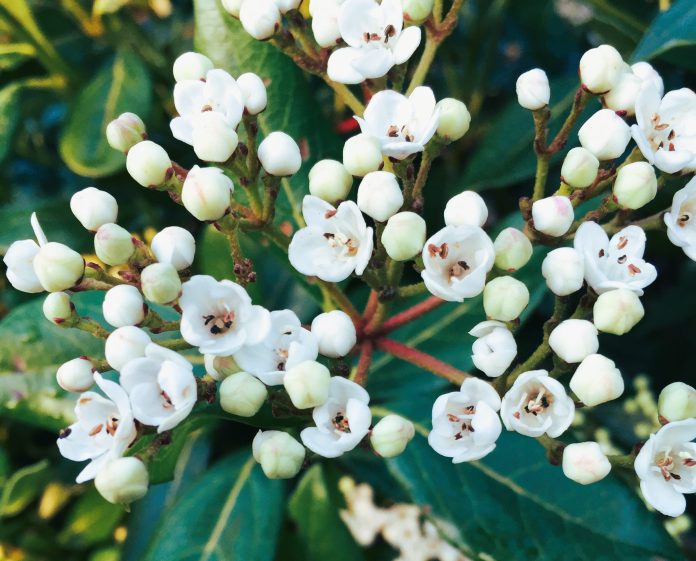Viburnum tinus, or Laurustinus, is an evergreen shrub that provides year-round interest. Its main flowering period spans November to April, with clusters of pinkish-white blooms brightening the garden during the colder months. Follow this month-by-month guide to grow and care for Viburnum tinus successfully.
January – February: Winter Care
- Flowering Period: November to April. The flowers are in full bloom, adding winter cheer and providing nectar for pollinators on mild days.
- Tasks:
- Inspect for winter damage and remove any broken or dead branches.
- Water during dry spells if the soil isn’t frozen, especially for young shrubs.
March – April: Early Spring Maintenance
- Flowering Period: Viburnum tinus continues to bloom into early spring. Look out for the developing blue-black berries.
- Tasks:
- Prune lightly after flowering ends in late April to shape the plant and encourage fresh growth.
- Apply a balanced, slow-release fertilizer to support the upcoming growth season.
- Mulch around the base with compost or leaf mould to retain moisture and suppress weeds.
May – June: Active Growth
- Tasks:
- Water regularly during dry periods, especially for newly planted shrubs.
- Monitor for powdery mildew, particularly in humid conditions, and improve air circulation if needed.
- Deadhead any remaining spent flowers to tidy the plant.
July – August: Summer Management
- Tasks:
- Water during prolonged dry spells, ensuring deep watering for young or container-grown plants.
- Check for viburnum beetle damage. Remove larvae by hand or use an appropriate treatment if necessary.
- Trim lightly to maintain a compact shape if required.
September – October: Preparing for Winter
- Tasks:
- Give a light prune if necessary, removing any damaged or weak stems.
- Apply a fresh layer of mulch to insulate roots before frost sets in.
- Consider planting new Viburnum tinus shrubs in early autumn to allow them time to establish.
November – December: Winter Highlights
- Flowering Period: The blooming season begins in November, with clusters of delicate pink buds opening to white flowers.
- Tasks:
- Protect young or newly planted shrubs from harsh frosts with fleece or windbreaks.
- Ensure the soil is moist before prolonged freezing weather to prevent stress on the roots.
General Tips for Growing Viburnum tinus
- Location: Thrives in sunny or partially shaded spots. It tolerates coastal winds and urban pollution, making it versatile for various settings.
- Soil: Adapts to most soils, including chalky or clay, but ensure good drainage.
- Planting: Space shrubs 1.5-2m apart to accommodate their mature size of up to 3m tall and wide.
- Companion Plants: Pair with winter-interest plants like hellebores, heathers, or evergreen grasses for a striking display.
By following this month-by-month guide, your Viburnum tinus will reward you with year-round beauty and resilience.




